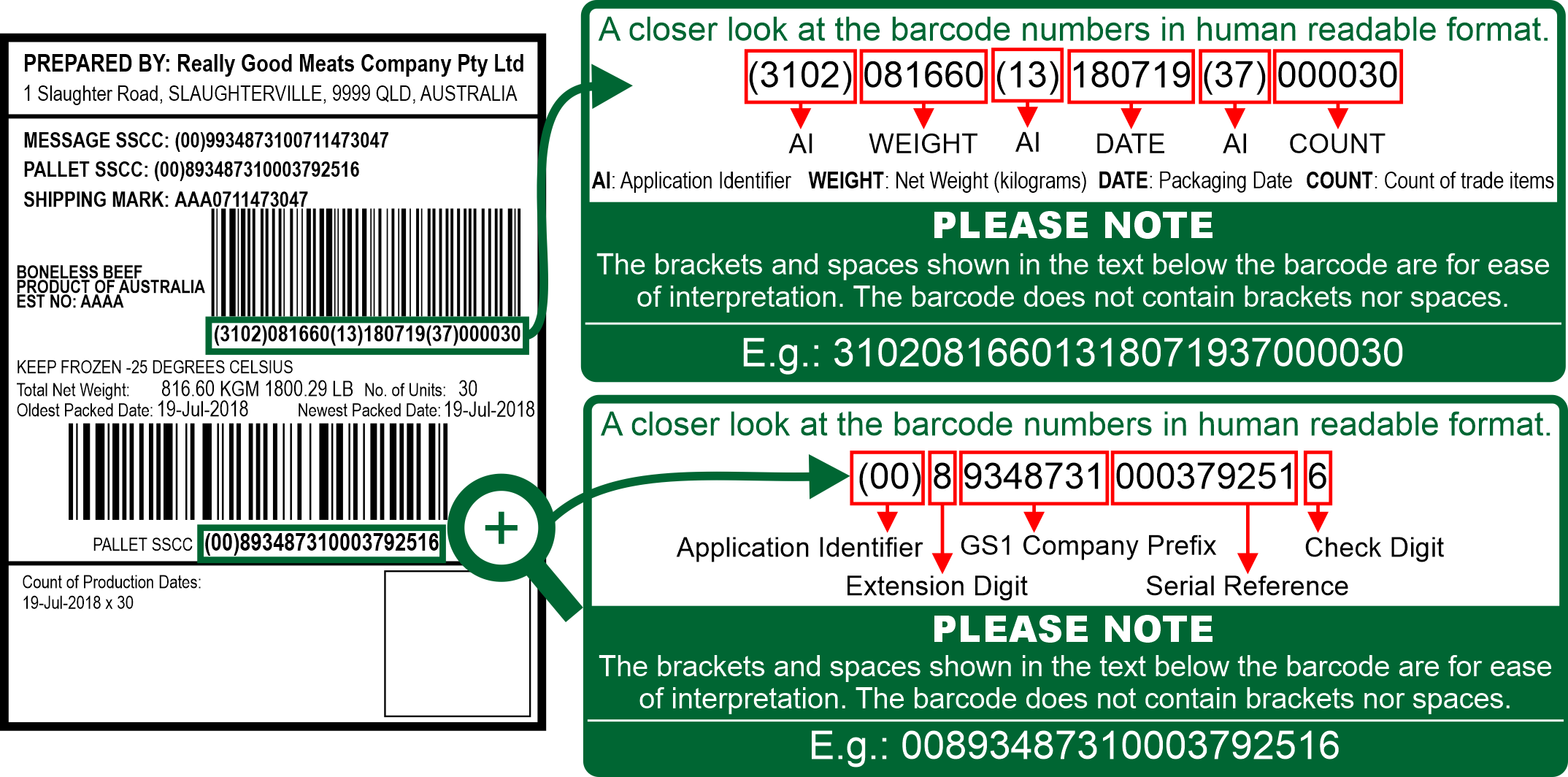RMSCC Supply Chain Information Standard
| Standard: | Pallet Labels - Export multiple product (barcodes) | ||||||||||||||||||||||||||||
|---|---|---|---|---|---|---|---|---|---|---|---|---|---|---|---|---|---|---|---|---|---|---|---|---|---|---|---|---|---|
| Status: | RELEASED | ||||||||||||||||||||||||||||
| Issue date: | |||||||||||||||||||||||||||||
| Endorsement: | |||||||||||||||||||||||||||||
| Purpose: |
The purpose of this standard is to define a consistent supply chain approach to the numbers and barcodes applied to pallets for ease of barcode scanning and data interoperability along the meat supply chain. The overall objective is to ensure that each participant along the meat supply chain can easily extract the trade information about a pallet carrying meat. The Pallet Label information standards are split into a series that covers differences in pallets that have single or multiple products, and pallets sent domestically and exported. Each pallet is barcoded following the GS1 standards, ensuring each pallet is assigned a global unique number that provides the basis for traceability along the whole supply chain. For more information on the GS1 standards go to: gs1.org |
||||||||||||||||||||||||||||
| Scope: |
Pallets can hold either single or multiple products and can be sent domestically or exported. In each case, the information that facilitates these transfers will require different needs. In response to those needs, the Pallet Label information standards are split into four sections. This information standard covers the data codification methods for barcode labels on non-retail pallets holding multiple products that are exported. The term "exported" refers to B2B transactions that cross country borders involved in international trade. Pallets exporting product are exposed to export and import government verification activities. The term "multiple products" refers to many products or trade items of different types. Products refers to meat and meat products sold by weight. |
||||||||||||||||||||||||||||
| References: |
This information standard is based on the GS1-128 Barcode Symbol, along with GS1 Application Identifiers. GS1 Application Identifiers covered in this standard include:
The AI (310n) is used as it captures net weight of variable weight products, which allows the weight to be allocated to an instance of a sold product. Check digits can be calculated through GS1. Please see the link below for further information. See AUS-MEAT trade descriptions for further information on meat sold by weight, and which products it may apply to. |
||||||||||||||||||||||||||||
| Details: |
Allocating a Serial Shipping Container Code The Serial Shipping Container Code (SSCC) is a unique, non-significant, eighteen-digit number, which is assigned by the company constructing the logistic unit. It remains the same for the life of the logistic unit. The SSCC is encoded in a GS1-128 Barcode Symbol and is identified by the Application Identifier (00). When assigning an SSCC, an individual SSCC number must not be reallocated within one year of the shipment date from the SSCC assignor to a trading partner.
Labelling the Logistic Unit The organisation responsible for the printing and application of the label determines the content format and the dimensions of the label. However, the SSCC is the minimum requirement in the logistics label. Any other information over and above the SSCC should comply with the specification of this section and with the proper use of AIs.
Label Layout
For each label applied to the logistic unit, the top section contains free format information, the middle section contains text information and the Human Readable Interpretation of the barcode symbol(s), and the lowest section contains the barcode symbols. In all cases the SSCC is placed in the lowest portion of the label. Barcode Symbol Specifications The GS1-128 (previously UCC/EAN-128) Barcode Symbol is used for GS1 Logistics Labels.
|
||||||||||||||||||||||||||||
| Comments and Feedback: |
Comments and feedback about this standard are sort from industry. This includes any requests for any enhancements or changes. Any submitted comments, feedback or change requests are reviewed by the Work Group following the RMSCC Core Principles and the RMSCC Standards Development model. To submit comments, feedback or change requests click on this link: RMSCC Feedback and Change Requests. |
||||||||||||||||||||||||||||
| Additional information: |
Additional information is available from: |
